Roles and Responsibilities of Leaders and Managers at Mark & Spencer's
VerifiedAdded on 2023/03/24
|11
|3549
|56
Report
AI Summary
This report provides an in-depth analysis of the roles and responsibilities of leaders and managers within Mark & Spencer's, a multinational retail firm. It distinguishes between leaders and managers, highlighting their differing approaches to building relationships, managing risk, and driving change. The report explores various leadership theories and models, including system theory, contingency theory, and situational theory, and their application within the company. It also discusses operational management approaches such as the Six Sigma approach and emphasizes the importance of operations management in achieving business objectives and goals, such as improving productivity and ensuring efficiency within the organization. The report underscores the significance of effective leadership and management in achieving organizational targets and maintaining a competitive edge in the retail sector. This report is contributed by a student and is available on Desklib, a platform providing AI-based study tools for students.
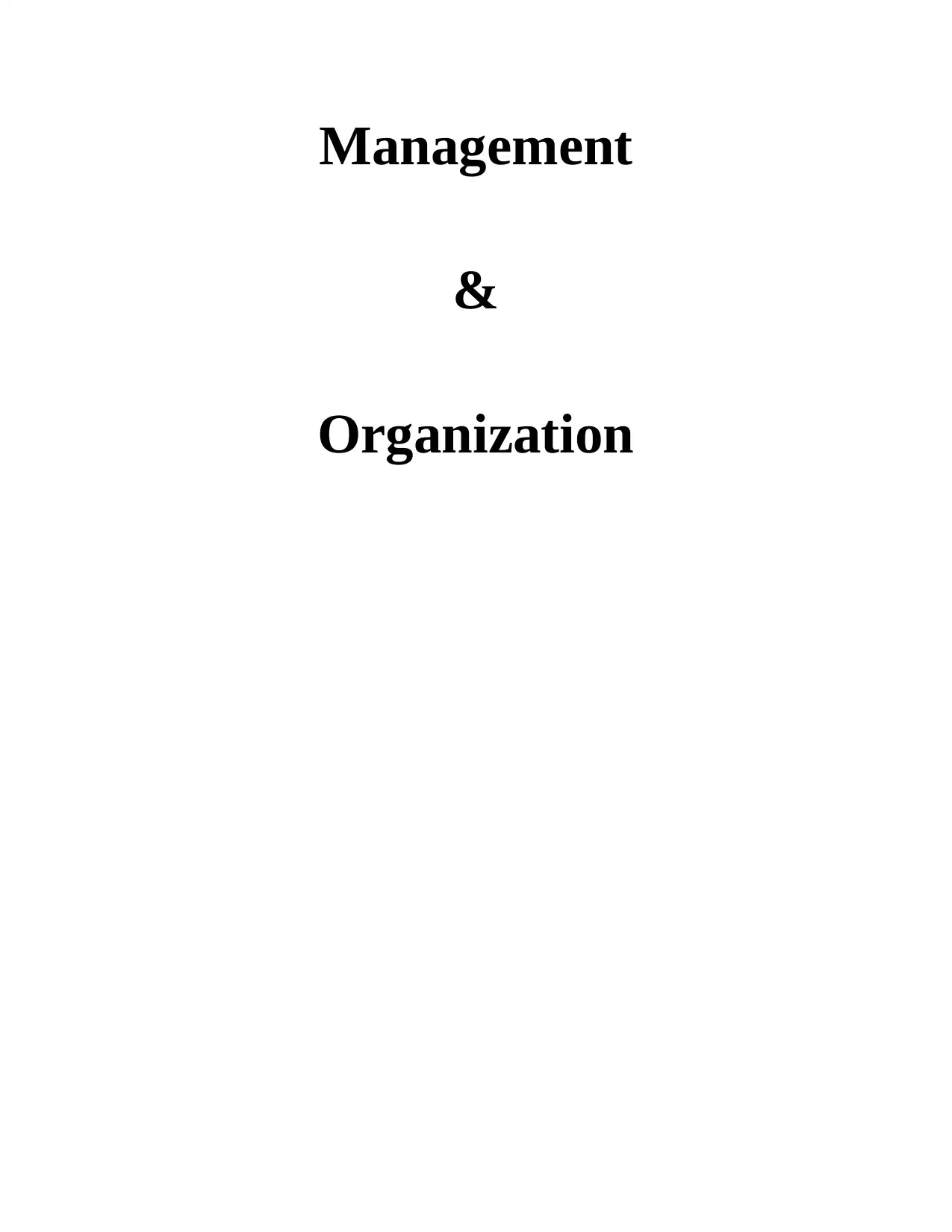
Management
&
Organization
&
Organization
Paraphrase This Document
Need a fresh take? Get an instant paraphrase of this document with our AI Paraphraser
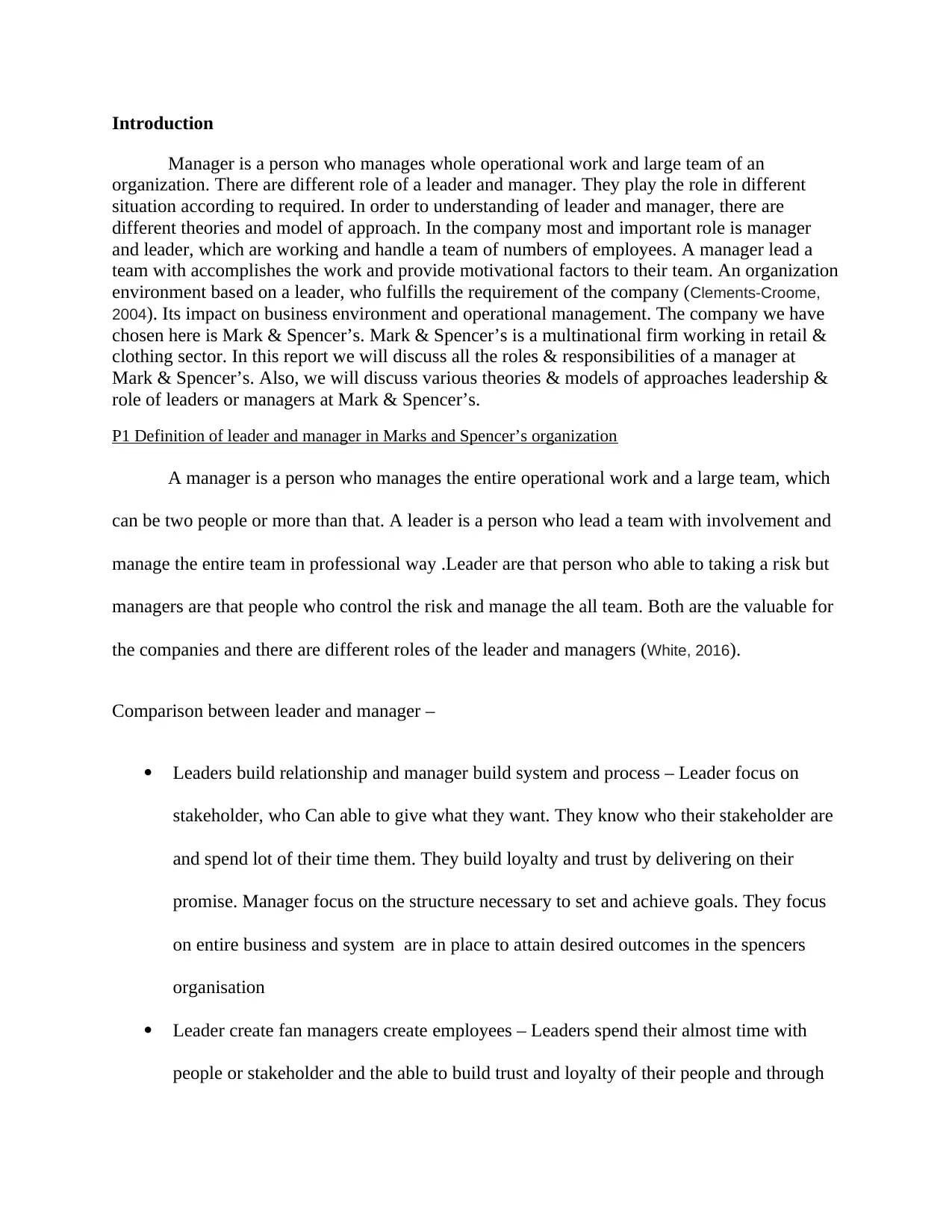
Introduction
Manager is a person who manages whole operational work and large team of an
organization. There are different role of a leader and manager. They play the role in different
situation according to required. In order to understanding of leader and manager, there are
different theories and model of approach. In the company most and important role is manager
and leader, which are working and handle a team of numbers of employees. A manager lead a
team with accomplishes the work and provide motivational factors to their team. An organization
environment based on a leader, who fulfills the requirement of the company (Clements-Croome,
2004). Its impact on business environment and operational management. The company we have
chosen here is Mark & Spencer’s. Mark & Spencer’s is a multinational firm working in retail &
clothing sector. In this report we will discuss all the roles & responsibilities of a manager at
Mark & Spencer’s. Also, we will discuss various theories & models of approaches leadership &
role of leaders or managers at Mark & Spencer’s.
P1 Definition of leader and manager in Marks and Spencer’s organization
A manager is a person who manages the entire operational work and a large team, which
can be two people or more than that. A leader is a person who lead a team with involvement and
manage the entire team in professional way .Leader are that person who able to taking a risk but
managers are that people who control the risk and manage the all team. Both are the valuable for
the companies and there are different roles of the leader and managers (White, 2016).
Comparison between leader and manager –
Leaders build relationship and manager build system and process – Leader focus on
stakeholder, who Can able to give what they want. They know who their stakeholder are
and spend lot of their time them. They build loyalty and trust by delivering on their
promise. Manager focus on the structure necessary to set and achieve goals. They focus
on entire business and system are in place to attain desired outcomes in the spencers
organisation
Leader create fan managers create employees – Leaders spend their almost time with
people or stakeholder and the able to build trust and loyalty of their people and through
Manager is a person who manages whole operational work and large team of an
organization. There are different role of a leader and manager. They play the role in different
situation according to required. In order to understanding of leader and manager, there are
different theories and model of approach. In the company most and important role is manager
and leader, which are working and handle a team of numbers of employees. A manager lead a
team with accomplishes the work and provide motivational factors to their team. An organization
environment based on a leader, who fulfills the requirement of the company (Clements-Croome,
2004). Its impact on business environment and operational management. The company we have
chosen here is Mark & Spencer’s. Mark & Spencer’s is a multinational firm working in retail &
clothing sector. In this report we will discuss all the roles & responsibilities of a manager at
Mark & Spencer’s. Also, we will discuss various theories & models of approaches leadership &
role of leaders or managers at Mark & Spencer’s.
P1 Definition of leader and manager in Marks and Spencer’s organization
A manager is a person who manages the entire operational work and a large team, which
can be two people or more than that. A leader is a person who lead a team with involvement and
manage the entire team in professional way .Leader are that person who able to taking a risk but
managers are that people who control the risk and manage the all team. Both are the valuable for
the companies and there are different roles of the leader and managers (White, 2016).
Comparison between leader and manager –
Leaders build relationship and manager build system and process – Leader focus on
stakeholder, who Can able to give what they want. They know who their stakeholder are
and spend lot of their time them. They build loyalty and trust by delivering on their
promise. Manager focus on the structure necessary to set and achieve goals. They focus
on entire business and system are in place to attain desired outcomes in the spencers
organisation
Leader create fan managers create employees – Leaders spend their almost time with
people or stakeholder and the able to build trust and loyalty of their people and through
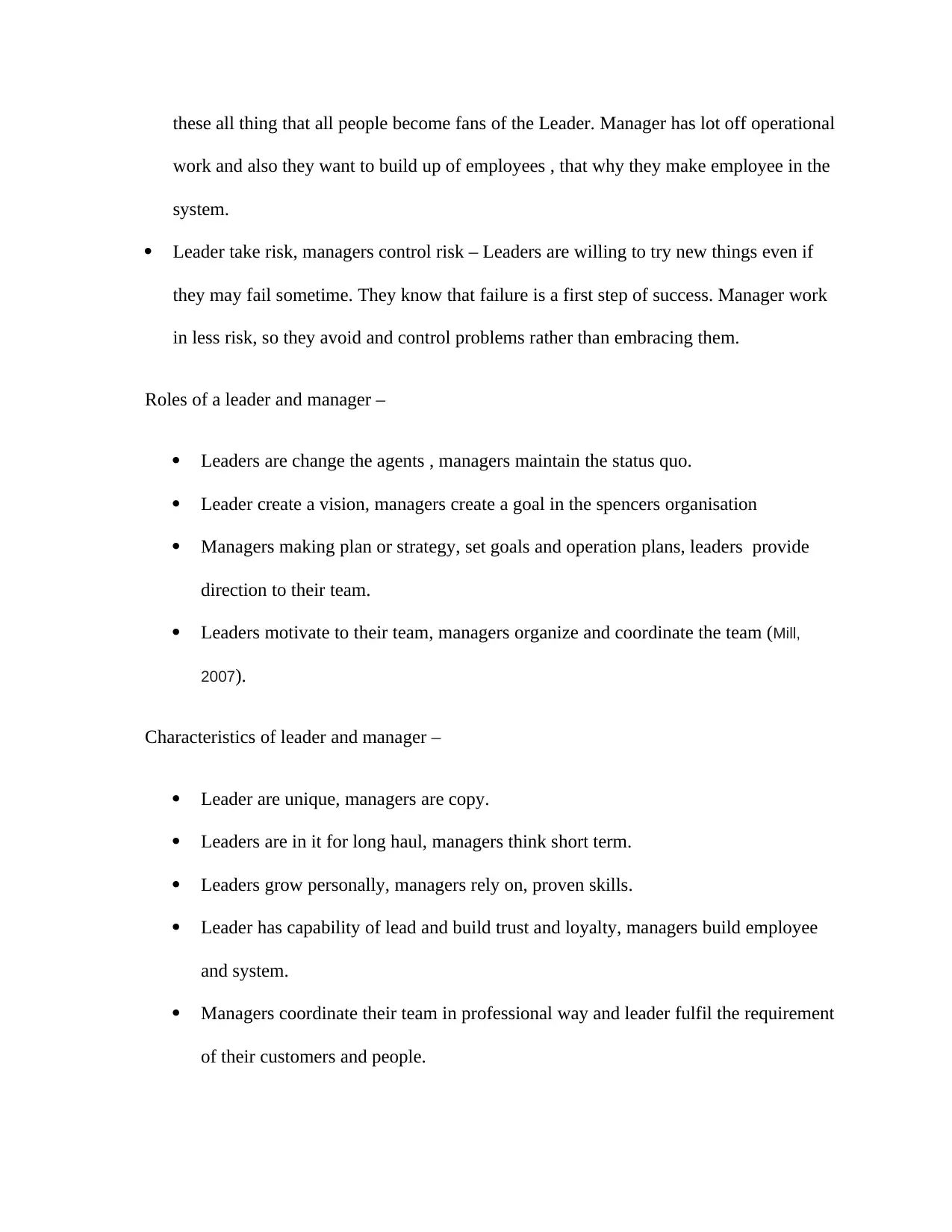
these all thing that all people become fans of the Leader. Manager has lot off operational
work and also they want to build up of employees , that why they make employee in the
system.
Leader take risk, managers control risk – Leaders are willing to try new things even if
they may fail sometime. They know that failure is a first step of success. Manager work
in less risk, so they avoid and control problems rather than embracing them.
Roles of a leader and manager –
Leaders are change the agents , managers maintain the status quo.
Leader create a vision, managers create a goal in the spencers organisation
Managers making plan or strategy, set goals and operation plans, leaders provide
direction to their team.
Leaders motivate to their team, managers organize and coordinate the team (Mill,
2007).
Characteristics of leader and manager –
Leader are unique, managers are copy.
Leaders are in it for long haul, managers think short term.
Leaders grow personally, managers rely on, proven skills.
Leader has capability of lead and build trust and loyalty, managers build employee
and system.
Managers coordinate their team in professional way and leader fulfil the requirement
of their customers and people.
work and also they want to build up of employees , that why they make employee in the
system.
Leader take risk, managers control risk – Leaders are willing to try new things even if
they may fail sometime. They know that failure is a first step of success. Manager work
in less risk, so they avoid and control problems rather than embracing them.
Roles of a leader and manager –
Leaders are change the agents , managers maintain the status quo.
Leader create a vision, managers create a goal in the spencers organisation
Managers making plan or strategy, set goals and operation plans, leaders provide
direction to their team.
Leaders motivate to their team, managers organize and coordinate the team (Mill,
2007).
Characteristics of leader and manager –
Leader are unique, managers are copy.
Leaders are in it for long haul, managers think short term.
Leaders grow personally, managers rely on, proven skills.
Leader has capability of lead and build trust and loyalty, managers build employee
and system.
Managers coordinate their team in professional way and leader fulfil the requirement
of their customers and people.
⊘ This is a preview!⊘
Do you want full access?
Subscribe today to unlock all pages.

Trusted by 1+ million students worldwide
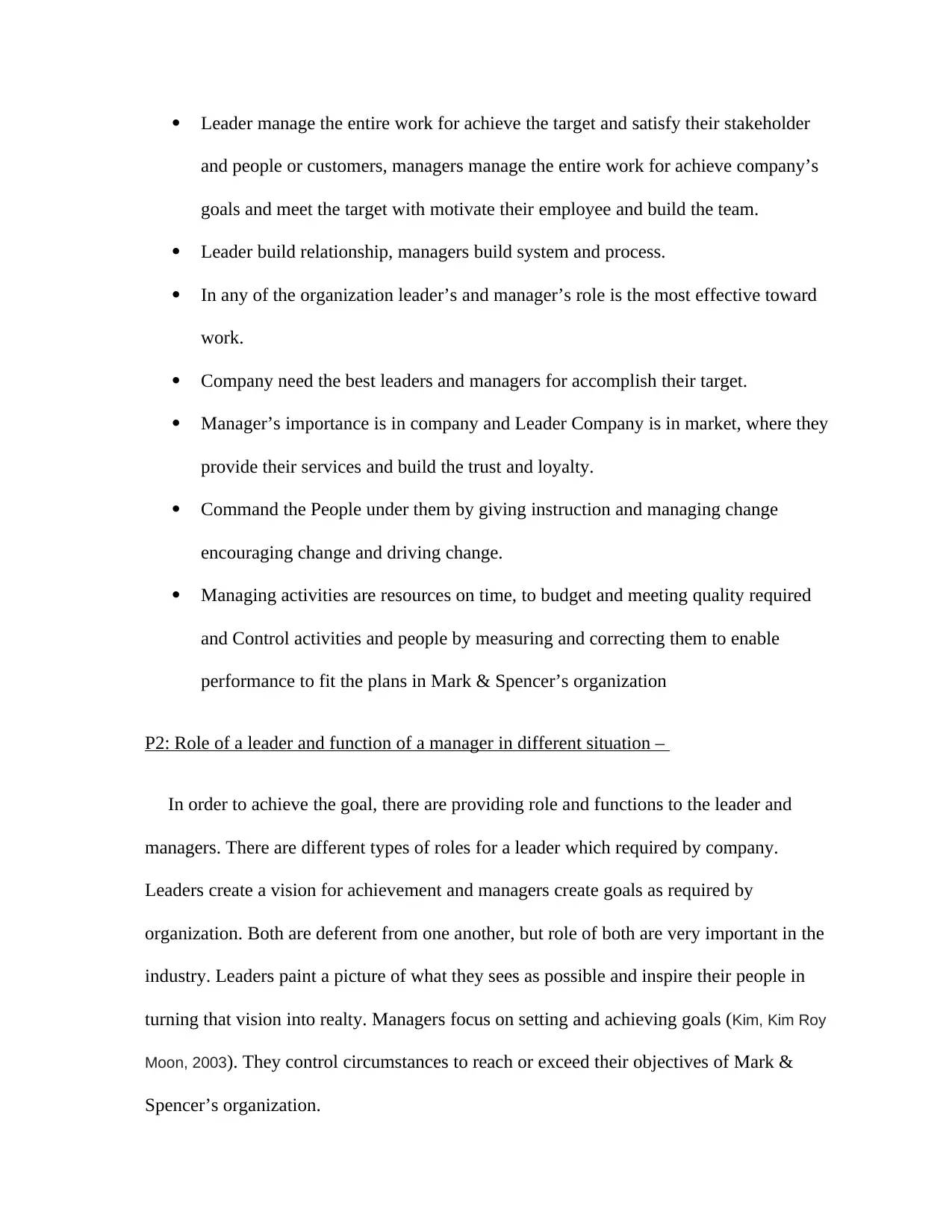
Leader manage the entire work for achieve the target and satisfy their stakeholder
and people or customers, managers manage the entire work for achieve company’s
goals and meet the target with motivate their employee and build the team.
Leader build relationship, managers build system and process.
In any of the organization leader’s and manager’s role is the most effective toward
work.
Company need the best leaders and managers for accomplish their target.
Manager’s importance is in company and Leader Company is in market, where they
provide their services and build the trust and loyalty.
Command the People under them by giving instruction and managing change
encouraging change and driving change.
Managing activities are resources on time, to budget and meeting quality required
and Control activities and people by measuring and correcting them to enable
performance to fit the plans in Mark & Spencer’s organization
P2: Role of a leader and function of a manager in different situation –
In order to achieve the goal, there are providing role and functions to the leader and
managers. There are different types of roles for a leader which required by company.
Leaders create a vision for achievement and managers create goals as required by
organization. Both are deferent from one another, but role of both are very important in the
industry. Leaders paint a picture of what they sees as possible and inspire their people in
turning that vision into realty. Managers focus on setting and achieving goals (Kim, Kim Roy
Moon, 2003). They control circumstances to reach or exceed their objectives of Mark &
Spencer’s organization.
and people or customers, managers manage the entire work for achieve company’s
goals and meet the target with motivate their employee and build the team.
Leader build relationship, managers build system and process.
In any of the organization leader’s and manager’s role is the most effective toward
work.
Company need the best leaders and managers for accomplish their target.
Manager’s importance is in company and Leader Company is in market, where they
provide their services and build the trust and loyalty.
Command the People under them by giving instruction and managing change
encouraging change and driving change.
Managing activities are resources on time, to budget and meeting quality required
and Control activities and people by measuring and correcting them to enable
performance to fit the plans in Mark & Spencer’s organization
P2: Role of a leader and function of a manager in different situation –
In order to achieve the goal, there are providing role and functions to the leader and
managers. There are different types of roles for a leader which required by company.
Leaders create a vision for achievement and managers create goals as required by
organization. Both are deferent from one another, but role of both are very important in the
industry. Leaders paint a picture of what they sees as possible and inspire their people in
turning that vision into realty. Managers focus on setting and achieving goals (Kim, Kim Roy
Moon, 2003). They control circumstances to reach or exceed their objectives of Mark &
Spencer’s organization.
Paraphrase This Document
Need a fresh take? Get an instant paraphrase of this document with our AI Paraphraser
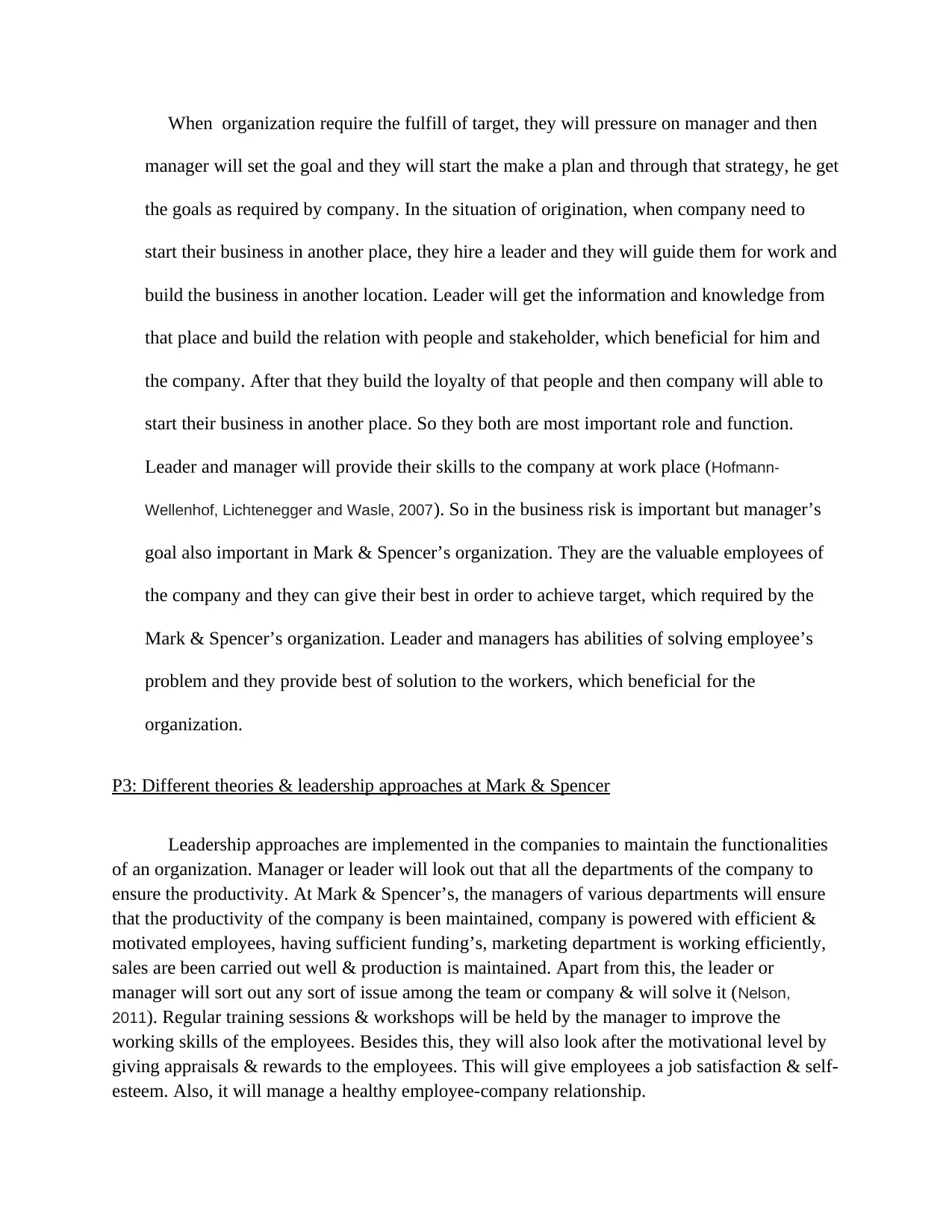
When organization require the fulfill of target, they will pressure on manager and then
manager will set the goal and they will start the make a plan and through that strategy, he get
the goals as required by company. In the situation of origination, when company need to
start their business in another place, they hire a leader and they will guide them for work and
build the business in another location. Leader will get the information and knowledge from
that place and build the relation with people and stakeholder, which beneficial for him and
the company. After that they build the loyalty of that people and then company will able to
start their business in another place. So they both are most important role and function.
Leader and manager will provide their skills to the company at work place (Hofmann-
Wellenhof, Lichtenegger and Wasle, 2007). So in the business risk is important but manager’s
goal also important in Mark & Spencer’s organization. They are the valuable employees of
the company and they can give their best in order to achieve target, which required by the
Mark & Spencer’s organization. Leader and managers has abilities of solving employee’s
problem and they provide best of solution to the workers, which beneficial for the
organization.
P3: Different theories & leadership approaches at Mark & Spencer
Leadership approaches are implemented in the companies to maintain the functionalities
of an organization. Manager or leader will look out that all the departments of the company to
ensure the productivity. At Mark & Spencer’s, the managers of various departments will ensure
that the productivity of the company is been maintained, company is powered with efficient &
motivated employees, having sufficient funding’s, marketing department is working efficiently,
sales are been carried out well & production is maintained. Apart from this, the leader or
manager will sort out any sort of issue among the team or company & will solve it (Nelson,
2011). Regular training sessions & workshops will be held by the manager to improve the
working skills of the employees. Besides this, they will also look after the motivational level by
giving appraisals & rewards to the employees. This will give employees a job satisfaction & self-
esteem. Also, it will manage a healthy employee-company relationship.
manager will set the goal and they will start the make a plan and through that strategy, he get
the goals as required by company. In the situation of origination, when company need to
start their business in another place, they hire a leader and they will guide them for work and
build the business in another location. Leader will get the information and knowledge from
that place and build the relation with people and stakeholder, which beneficial for him and
the company. After that they build the loyalty of that people and then company will able to
start their business in another place. So they both are most important role and function.
Leader and manager will provide their skills to the company at work place (Hofmann-
Wellenhof, Lichtenegger and Wasle, 2007). So in the business risk is important but manager’s
goal also important in Mark & Spencer’s organization. They are the valuable employees of
the company and they can give their best in order to achieve target, which required by the
Mark & Spencer’s organization. Leader and managers has abilities of solving employee’s
problem and they provide best of solution to the workers, which beneficial for the
organization.
P3: Different theories & leadership approaches at Mark & Spencer
Leadership approaches are implemented in the companies to maintain the functionalities
of an organization. Manager or leader will look out that all the departments of the company to
ensure the productivity. At Mark & Spencer’s, the managers of various departments will ensure
that the productivity of the company is been maintained, company is powered with efficient &
motivated employees, having sufficient funding’s, marketing department is working efficiently,
sales are been carried out well & production is maintained. Apart from this, the leader or
manager will sort out any sort of issue among the team or company & will solve it (Nelson,
2011). Regular training sessions & workshops will be held by the manager to improve the
working skills of the employees. Besides this, they will also look after the motivational level by
giving appraisals & rewards to the employees. This will give employees a job satisfaction & self-
esteem. Also, it will manage a healthy employee-company relationship.
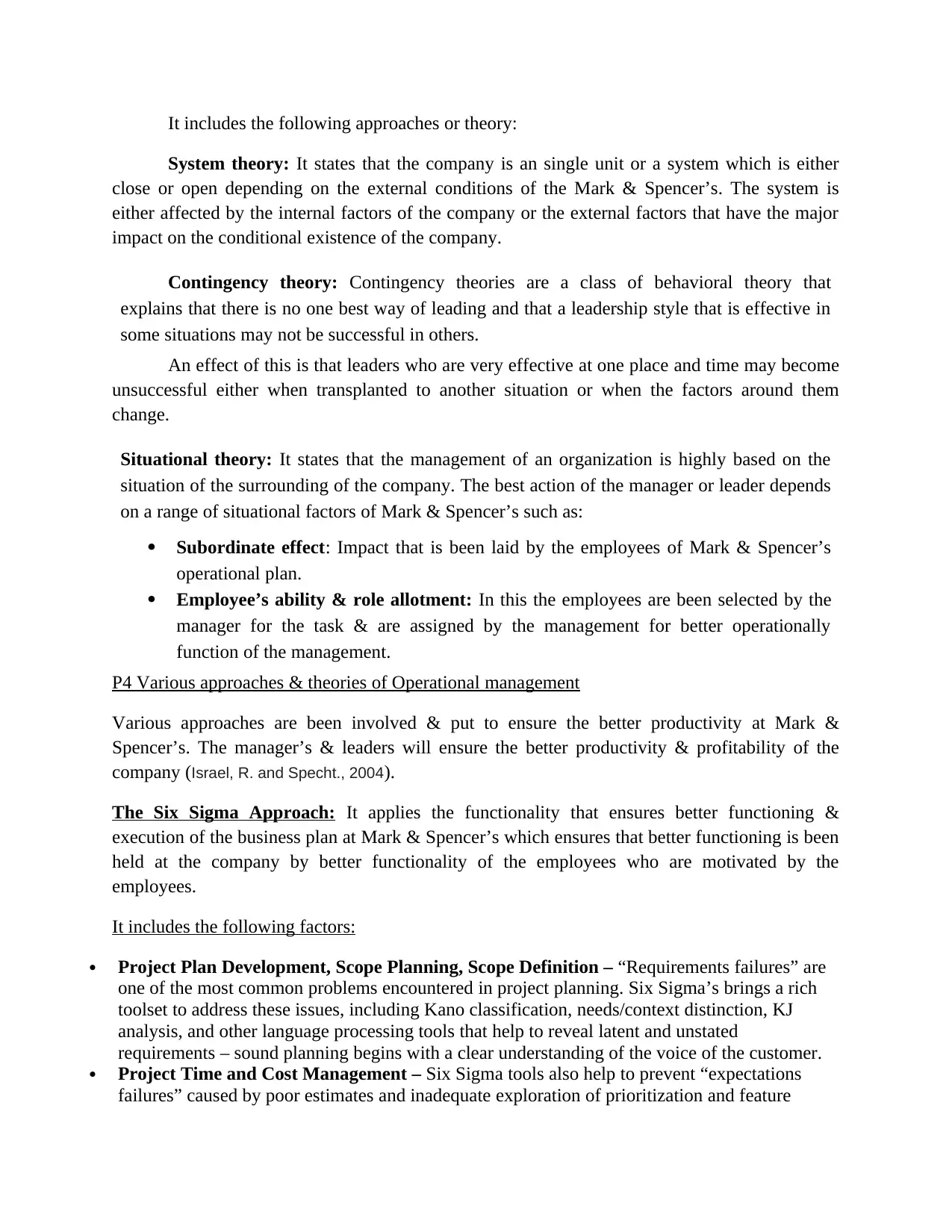
It includes the following approaches or theory:
System theory: It states that the company is an single unit or a system which is either
close or open depending on the external conditions of the Mark & Spencer’s. The system is
either affected by the internal factors of the company or the external factors that have the major
impact on the conditional existence of the company.
Contingency theory: Contingency theories are a class of behavioral theory that
explains that there is no one best way of leading and that a leadership style that is effective in
some situations may not be successful in others.
An effect of this is that leaders who are very effective at one place and time may become
unsuccessful either when transplanted to another situation or when the factors around them
change.
Situational theory: It states that the management of an organization is highly based on the
situation of the surrounding of the company. The best action of the manager or leader depends
on a range of situational factors of Mark & Spencer’s such as:
Subordinate effect: Impact that is been laid by the employees of Mark & Spencer’s
operational plan.
Employee’s ability & role allotment: In this the employees are been selected by the
manager for the task & are assigned by the management for better operationally
function of the management.
P4 Various approaches & theories of Operational management
Various approaches are been involved & put to ensure the better productivity at Mark &
Spencer’s. The manager’s & leaders will ensure the better productivity & profitability of the
company (Israel, R. and Specht., 2004).
The Six Sigma Approach: It applies the functionality that ensures better functioning &
execution of the business plan at Mark & Spencer’s which ensures that better functioning is been
held at the company by better functionality of the employees who are motivated by the
employees.
It includes the following factors:
Project Plan Development, Scope Planning, Scope Definition – “Requirements failures” are
one of the most common problems encountered in project planning. Six Sigma’s brings a rich
toolset to address these issues, including Kano classification, needs/context distinction, KJ
analysis, and other language processing tools that help to reveal latent and unstated
requirements – sound planning begins with a clear understanding of the voice of the customer.
Project Time and Cost Management – Six Sigma tools also help to prevent “expectations
failures” caused by poor estimates and inadequate exploration of prioritization and feature
System theory: It states that the company is an single unit or a system which is either
close or open depending on the external conditions of the Mark & Spencer’s. The system is
either affected by the internal factors of the company or the external factors that have the major
impact on the conditional existence of the company.
Contingency theory: Contingency theories are a class of behavioral theory that
explains that there is no one best way of leading and that a leadership style that is effective in
some situations may not be successful in others.
An effect of this is that leaders who are very effective at one place and time may become
unsuccessful either when transplanted to another situation or when the factors around them
change.
Situational theory: It states that the management of an organization is highly based on the
situation of the surrounding of the company. The best action of the manager or leader depends
on a range of situational factors of Mark & Spencer’s such as:
Subordinate effect: Impact that is been laid by the employees of Mark & Spencer’s
operational plan.
Employee’s ability & role allotment: In this the employees are been selected by the
manager for the task & are assigned by the management for better operationally
function of the management.
P4 Various approaches & theories of Operational management
Various approaches are been involved & put to ensure the better productivity at Mark &
Spencer’s. The manager’s & leaders will ensure the better productivity & profitability of the
company (Israel, R. and Specht., 2004).
The Six Sigma Approach: It applies the functionality that ensures better functioning &
execution of the business plan at Mark & Spencer’s which ensures that better functioning is been
held at the company by better functionality of the employees who are motivated by the
employees.
It includes the following factors:
Project Plan Development, Scope Planning, Scope Definition – “Requirements failures” are
one of the most common problems encountered in project planning. Six Sigma’s brings a rich
toolset to address these issues, including Kano classification, needs/context distinction, KJ
analysis, and other language processing tools that help to reveal latent and unstated
requirements – sound planning begins with a clear understanding of the voice of the customer.
Project Time and Cost Management – Six Sigma tools also help to prevent “expectations
failures” caused by poor estimates and inadequate exploration of prioritization and feature
⊘ This is a preview!⊘
Do you want full access?
Subscribe today to unlock all pages.

Trusted by 1+ million students worldwide
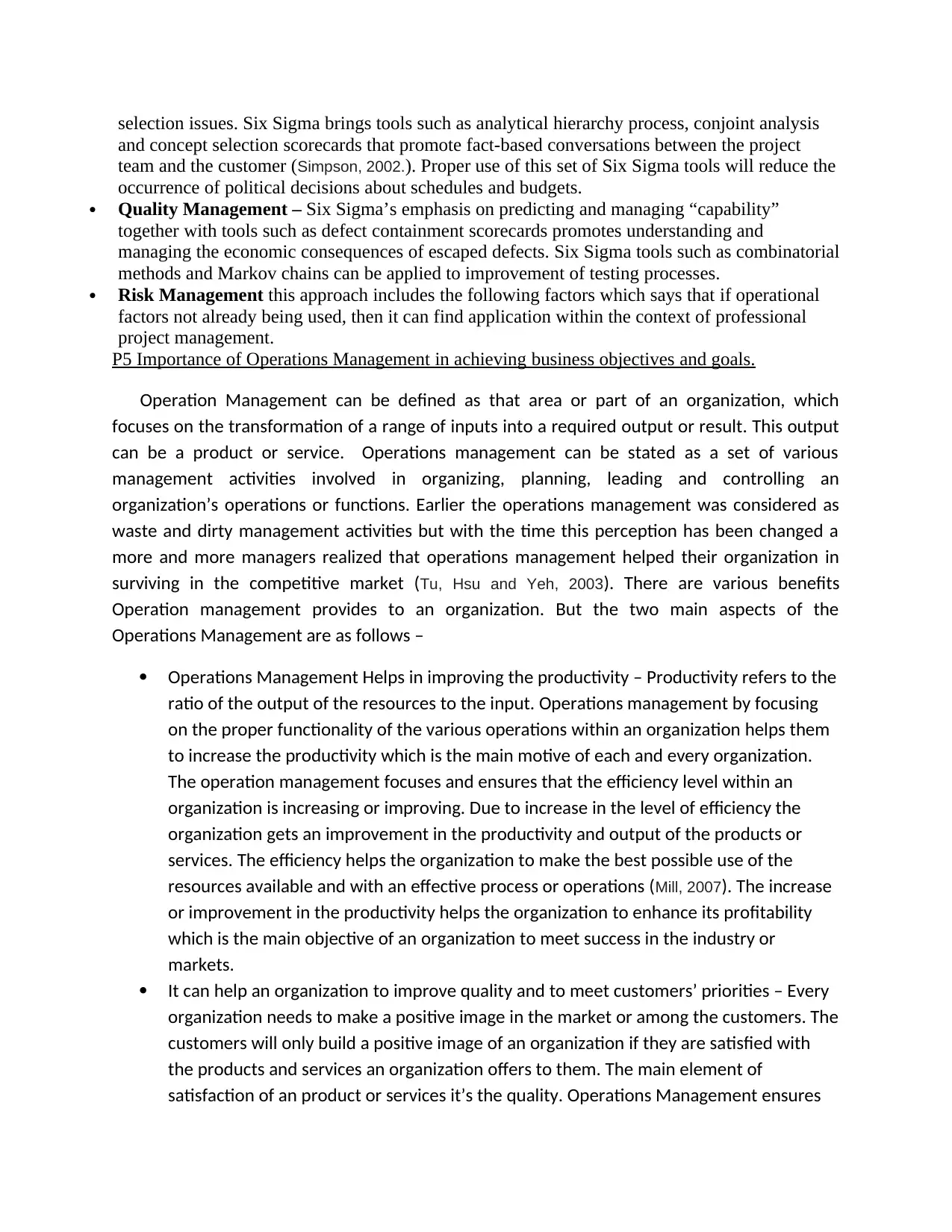
selection issues. Six Sigma brings tools such as analytical hierarchy process, conjoint analysis
and concept selection scorecards that promote fact-based conversations between the project
team and the customer (Simpson, 2002.). Proper use of this set of Six Sigma tools will reduce the
occurrence of political decisions about schedules and budgets.
Quality Management – Six Sigma’s emphasis on predicting and managing “capability”
together with tools such as defect containment scorecards promotes understanding and
managing the economic consequences of escaped defects. Six Sigma tools such as combinatorial
methods and Markov chains can be applied to improvement of testing processes.
Risk Management this approach includes the following factors which says that if operational
factors not already being used, then it can find application within the context of professional
project management.
P5 Importance of Operations Management in achieving business objectives and goals.
Operation Management can be defined as that area or part of an organization, which
focuses on the transformation of a range of inputs into a required output or result. This output
can be a product or service. Operations management can be stated as a set of various
management activities involved in organizing, planning, leading and controlling an
organization’s operations or functions. Earlier the operations management was considered as
waste and dirty management activities but with the time this perception has been changed a
more and more managers realized that operations management helped their organization in
surviving in the competitive market (Tu, Hsu and Yeh, 2003). There are various benefits
Operation management provides to an organization. But the two main aspects of the
Operations Management are as follows –
Operations Management Helps in improving the productivity – Productivity refers to the
ratio of the output of the resources to the input. Operations management by focusing
on the proper functionality of the various operations within an organization helps them
to increase the productivity which is the main motive of each and every organization.
The operation management focuses and ensures that the efficiency level within an
organization is increasing or improving. Due to increase in the level of efficiency the
organization gets an improvement in the productivity and output of the products or
services. The efficiency helps the organization to make the best possible use of the
resources available and with an effective process or operations (Mill, 2007). The increase
or improvement in the productivity helps the organization to enhance its profitability
which is the main objective of an organization to meet success in the industry or
markets.
It can help an organization to improve quality and to meet customers’ priorities – Every
organization needs to make a positive image in the market or among the customers. The
customers will only build a positive image of an organization if they are satisfied with
the products and services an organization offers to them. The main element of
satisfaction of an product or services it’s the quality. Operations Management ensures
and concept selection scorecards that promote fact-based conversations between the project
team and the customer (Simpson, 2002.). Proper use of this set of Six Sigma tools will reduce the
occurrence of political decisions about schedules and budgets.
Quality Management – Six Sigma’s emphasis on predicting and managing “capability”
together with tools such as defect containment scorecards promotes understanding and
managing the economic consequences of escaped defects. Six Sigma tools such as combinatorial
methods and Markov chains can be applied to improvement of testing processes.
Risk Management this approach includes the following factors which says that if operational
factors not already being used, then it can find application within the context of professional
project management.
P5 Importance of Operations Management in achieving business objectives and goals.
Operation Management can be defined as that area or part of an organization, which
focuses on the transformation of a range of inputs into a required output or result. This output
can be a product or service. Operations management can be stated as a set of various
management activities involved in organizing, planning, leading and controlling an
organization’s operations or functions. Earlier the operations management was considered as
waste and dirty management activities but with the time this perception has been changed a
more and more managers realized that operations management helped their organization in
surviving in the competitive market (Tu, Hsu and Yeh, 2003). There are various benefits
Operation management provides to an organization. But the two main aspects of the
Operations Management are as follows –
Operations Management Helps in improving the productivity – Productivity refers to the
ratio of the output of the resources to the input. Operations management by focusing
on the proper functionality of the various operations within an organization helps them
to increase the productivity which is the main motive of each and every organization.
The operation management focuses and ensures that the efficiency level within an
organization is increasing or improving. Due to increase in the level of efficiency the
organization gets an improvement in the productivity and output of the products or
services. The efficiency helps the organization to make the best possible use of the
resources available and with an effective process or operations (Mill, 2007). The increase
or improvement in the productivity helps the organization to enhance its profitability
which is the main objective of an organization to meet success in the industry or
markets.
It can help an organization to improve quality and to meet customers’ priorities – Every
organization needs to make a positive image in the market or among the customers. The
customers will only build a positive image of an organization if they are satisfied with
the products and services an organization offers to them. The main element of
satisfaction of an product or services it’s the quality. Operations Management ensures
Paraphrase This Document
Need a fresh take? Get an instant paraphrase of this document with our AI Paraphraser
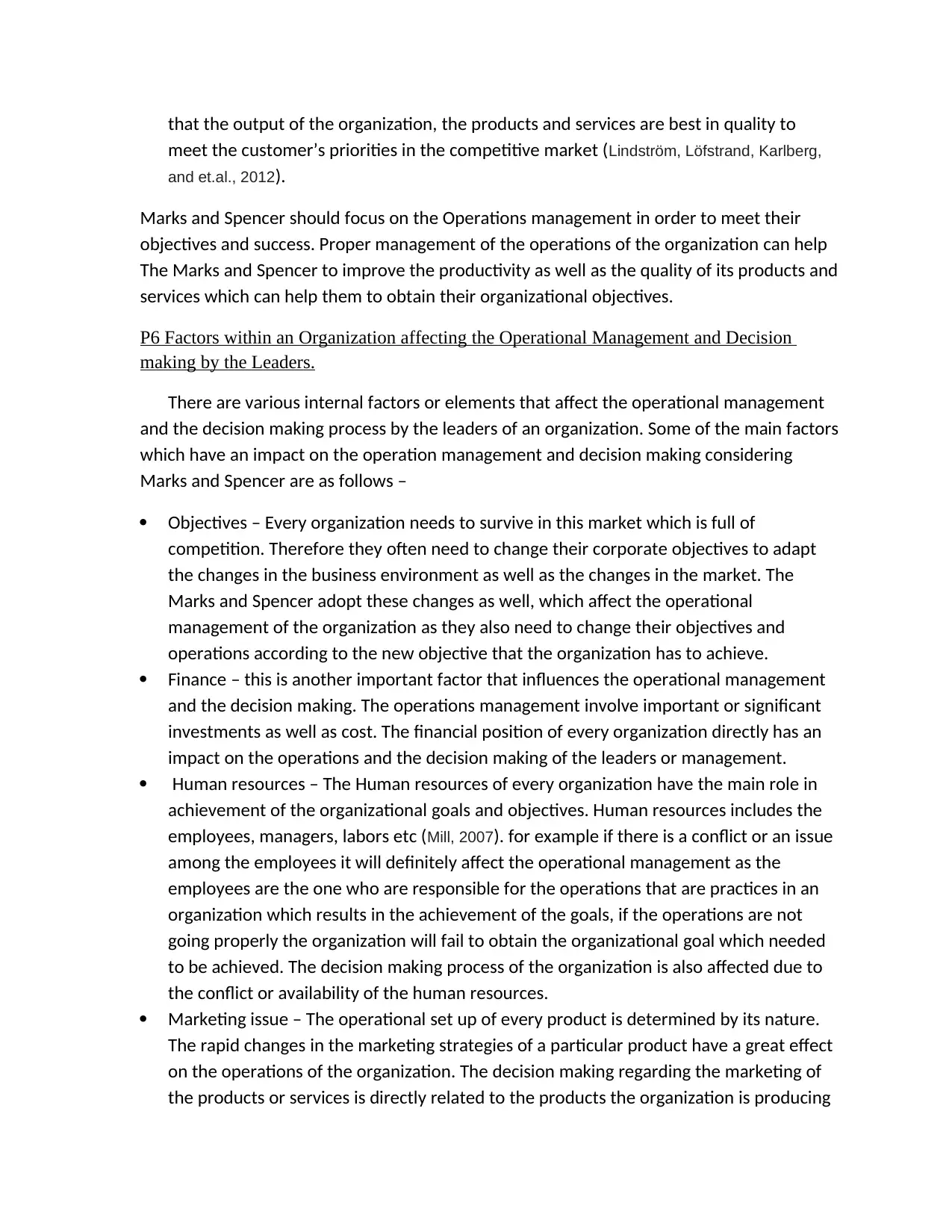
that the output of the organization, the products and services are best in quality to
meet the customer’s priorities in the competitive market (Lindström, Löfstrand, Karlberg,
and et.al., 2012).
Marks and Spencer should focus on the Operations management in order to meet their
objectives and success. Proper management of the operations of the organization can help
The Marks and Spencer to improve the productivity as well as the quality of its products and
services which can help them to obtain their organizational objectives.
P6 Factors within an Organization affecting the Operational Management and Decision
making by the Leaders.
There are various internal factors or elements that affect the operational management
and the decision making process by the leaders of an organization. Some of the main factors
which have an impact on the operation management and decision making considering
Marks and Spencer are as follows –
Objectives – Every organization needs to survive in this market which is full of
competition. Therefore they often need to change their corporate objectives to adapt
the changes in the business environment as well as the changes in the market. The
Marks and Spencer adopt these changes as well, which affect the operational
management of the organization as they also need to change their objectives and
operations according to the new objective that the organization has to achieve.
Finance – this is another important factor that influences the operational management
and the decision making. The operations management involve important or significant
investments as well as cost. The financial position of every organization directly has an
impact on the operations and the decision making of the leaders or management.
Human resources – The Human resources of every organization have the main role in
achievement of the organizational goals and objectives. Human resources includes the
employees, managers, labors etc (Mill, 2007). for example if there is a conflict or an issue
among the employees it will definitely affect the operational management as the
employees are the one who are responsible for the operations that are practices in an
organization which results in the achievement of the goals, if the operations are not
going properly the organization will fail to obtain the organizational goal which needed
to be achieved. The decision making process of the organization is also affected due to
the conflict or availability of the human resources.
Marketing issue – The operational set up of every product is determined by its nature.
The rapid changes in the marketing strategies of a particular product have a great effect
on the operations of the organization. The decision making regarding the marketing of
the products or services is directly related to the products the organization is producing
meet the customer’s priorities in the competitive market (Lindström, Löfstrand, Karlberg,
and et.al., 2012).
Marks and Spencer should focus on the Operations management in order to meet their
objectives and success. Proper management of the operations of the organization can help
The Marks and Spencer to improve the productivity as well as the quality of its products and
services which can help them to obtain their organizational objectives.
P6 Factors within an Organization affecting the Operational Management and Decision
making by the Leaders.
There are various internal factors or elements that affect the operational management
and the decision making process by the leaders of an organization. Some of the main factors
which have an impact on the operation management and decision making considering
Marks and Spencer are as follows –
Objectives – Every organization needs to survive in this market which is full of
competition. Therefore they often need to change their corporate objectives to adapt
the changes in the business environment as well as the changes in the market. The
Marks and Spencer adopt these changes as well, which affect the operational
management of the organization as they also need to change their objectives and
operations according to the new objective that the organization has to achieve.
Finance – this is another important factor that influences the operational management
and the decision making. The operations management involve important or significant
investments as well as cost. The financial position of every organization directly has an
impact on the operations and the decision making of the leaders or management.
Human resources – The Human resources of every organization have the main role in
achievement of the organizational goals and objectives. Human resources includes the
employees, managers, labors etc (Mill, 2007). for example if there is a conflict or an issue
among the employees it will definitely affect the operational management as the
employees are the one who are responsible for the operations that are practices in an
organization which results in the achievement of the goals, if the operations are not
going properly the organization will fail to obtain the organizational goal which needed
to be achieved. The decision making process of the organization is also affected due to
the conflict or availability of the human resources.
Marketing issue – The operational set up of every product is determined by its nature.
The rapid changes in the marketing strategies of a particular product have a great effect
on the operations of the organization. The decision making regarding the marketing of
the products or services is directly related to the products the organization is producing
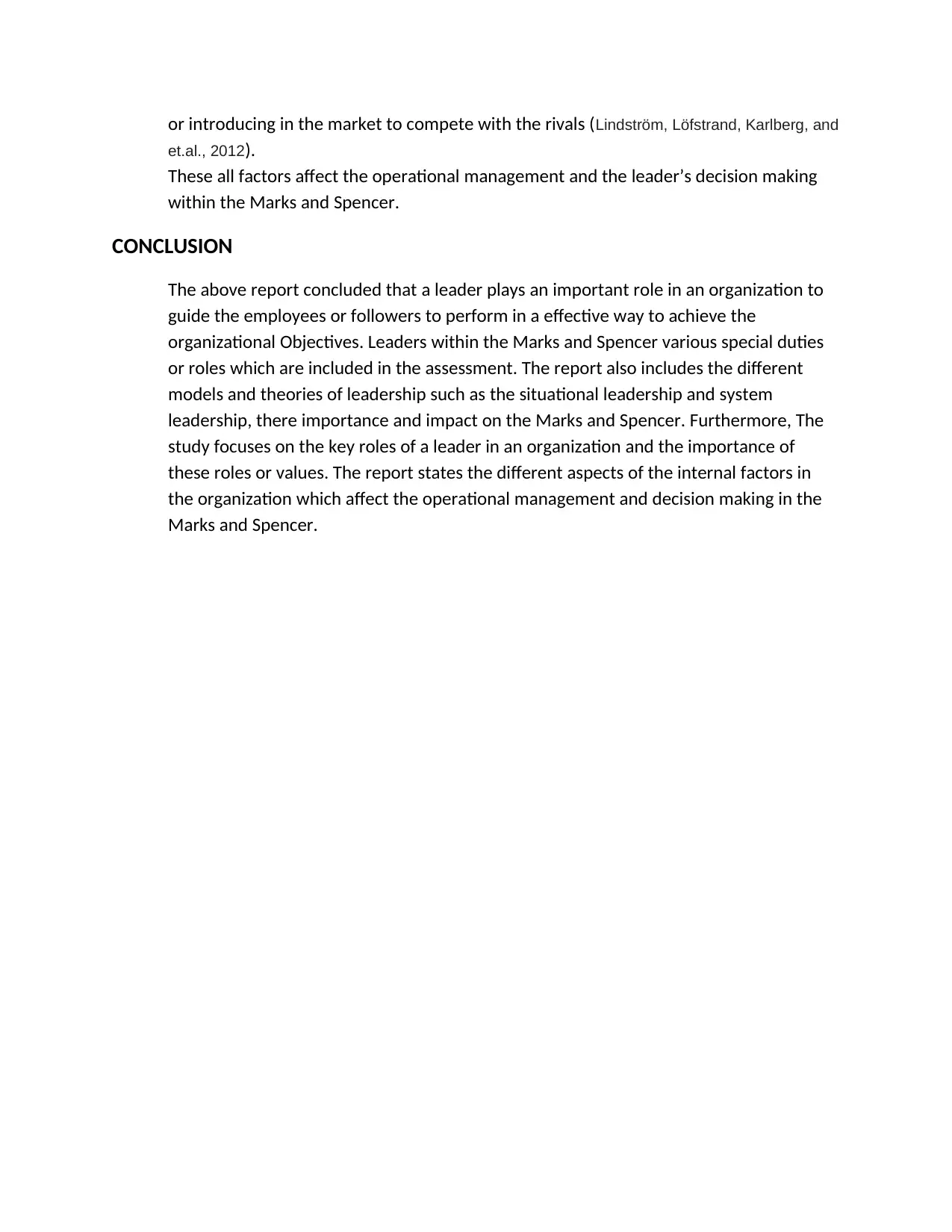
or introducing in the market to compete with the rivals (Lindström, Löfstrand, Karlberg, and
et.al., 2012).
These all factors affect the operational management and the leader’s decision making
within the Marks and Spencer.
CONCLUSION
The above report concluded that a leader plays an important role in an organization to
guide the employees or followers to perform in a effective way to achieve the
organizational Objectives. Leaders within the Marks and Spencer various special duties
or roles which are included in the assessment. The report also includes the different
models and theories of leadership such as the situational leadership and system
leadership, there importance and impact on the Marks and Spencer. Furthermore, The
study focuses on the key roles of a leader in an organization and the importance of
these roles or values. The report states the different aspects of the internal factors in
the organization which affect the operational management and decision making in the
Marks and Spencer.
et.al., 2012).
These all factors affect the operational management and the leader’s decision making
within the Marks and Spencer.
CONCLUSION
The above report concluded that a leader plays an important role in an organization to
guide the employees or followers to perform in a effective way to achieve the
organizational Objectives. Leaders within the Marks and Spencer various special duties
or roles which are included in the assessment. The report also includes the different
models and theories of leadership such as the situational leadership and system
leadership, there importance and impact on the Marks and Spencer. Furthermore, The
study focuses on the key roles of a leader in an organization and the importance of
these roles or values. The report states the different aspects of the internal factors in
the organization which affect the operational management and decision making in the
Marks and Spencer.
⊘ This is a preview!⊘
Do you want full access?
Subscribe today to unlock all pages.

Trusted by 1+ million students worldwide
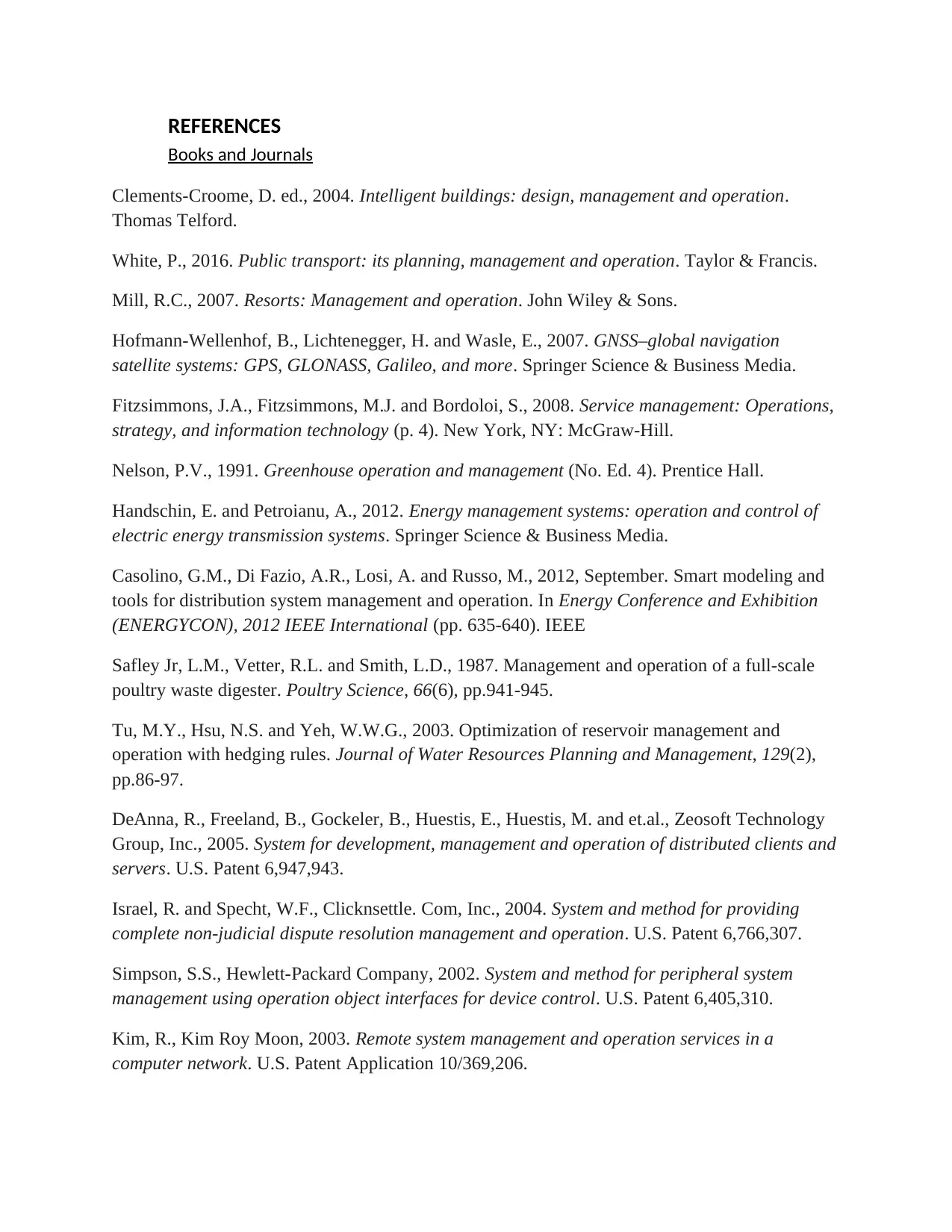
REFERENCES
Books and Journals
Clements-Croome, D. ed., 2004. Intelligent buildings: design, management and operation.
Thomas Telford.
White, P., 2016. Public transport: its planning, management and operation. Taylor & Francis.
Mill, R.C., 2007. Resorts: Management and operation. John Wiley & Sons.
Hofmann-Wellenhof, B., Lichtenegger, H. and Wasle, E., 2007. GNSS–global navigation
satellite systems: GPS, GLONASS, Galileo, and more. Springer Science & Business Media.
Fitzsimmons, J.A., Fitzsimmons, M.J. and Bordoloi, S., 2008. Service management: Operations,
strategy, and information technology (p. 4). New York, NY: McGraw-Hill.
Nelson, P.V., 1991. Greenhouse operation and management (No. Ed. 4). Prentice Hall.
Handschin, E. and Petroianu, A., 2012. Energy management systems: operation and control of
electric energy transmission systems. Springer Science & Business Media.
Casolino, G.M., Di Fazio, A.R., Losi, A. and Russo, M., 2012, September. Smart modeling and
tools for distribution system management and operation. In Energy Conference and Exhibition
(ENERGYCON), 2012 IEEE International (pp. 635-640). IEEE
Safley Jr, L.M., Vetter, R.L. and Smith, L.D., 1987. Management and operation of a full-scale
poultry waste digester. Poultry Science, 66(6), pp.941-945.
Tu, M.Y., Hsu, N.S. and Yeh, W.W.G., 2003. Optimization of reservoir management and
operation with hedging rules. Journal of Water Resources Planning and Management, 129(2),
pp.86-97.
DeAnna, R., Freeland, B., Gockeler, B., Huestis, E., Huestis, M. and et.al., Zeosoft Technology
Group, Inc., 2005. System for development, management and operation of distributed clients and
servers. U.S. Patent 6,947,943.
Israel, R. and Specht, W.F., Clicknsettle. Com, Inc., 2004. System and method for providing
complete non-judicial dispute resolution management and operation. U.S. Patent 6,766,307.
Simpson, S.S., Hewlett-Packard Company, 2002. System and method for peripheral system
management using operation object interfaces for device control. U.S. Patent 6,405,310.
Kim, R., Kim Roy Moon, 2003. Remote system management and operation services in a
computer network. U.S. Patent Application 10/369,206.
Books and Journals
Clements-Croome, D. ed., 2004. Intelligent buildings: design, management and operation.
Thomas Telford.
White, P., 2016. Public transport: its planning, management and operation. Taylor & Francis.
Mill, R.C., 2007. Resorts: Management and operation. John Wiley & Sons.
Hofmann-Wellenhof, B., Lichtenegger, H. and Wasle, E., 2007. GNSS–global navigation
satellite systems: GPS, GLONASS, Galileo, and more. Springer Science & Business Media.
Fitzsimmons, J.A., Fitzsimmons, M.J. and Bordoloi, S., 2008. Service management: Operations,
strategy, and information technology (p. 4). New York, NY: McGraw-Hill.
Nelson, P.V., 1991. Greenhouse operation and management (No. Ed. 4). Prentice Hall.
Handschin, E. and Petroianu, A., 2012. Energy management systems: operation and control of
electric energy transmission systems. Springer Science & Business Media.
Casolino, G.M., Di Fazio, A.R., Losi, A. and Russo, M., 2012, September. Smart modeling and
tools for distribution system management and operation. In Energy Conference and Exhibition
(ENERGYCON), 2012 IEEE International (pp. 635-640). IEEE
Safley Jr, L.M., Vetter, R.L. and Smith, L.D., 1987. Management and operation of a full-scale
poultry waste digester. Poultry Science, 66(6), pp.941-945.
Tu, M.Y., Hsu, N.S. and Yeh, W.W.G., 2003. Optimization of reservoir management and
operation with hedging rules. Journal of Water Resources Planning and Management, 129(2),
pp.86-97.
DeAnna, R., Freeland, B., Gockeler, B., Huestis, E., Huestis, M. and et.al., Zeosoft Technology
Group, Inc., 2005. System for development, management and operation of distributed clients and
servers. U.S. Patent 6,947,943.
Israel, R. and Specht, W.F., Clicknsettle. Com, Inc., 2004. System and method for providing
complete non-judicial dispute resolution management and operation. U.S. Patent 6,766,307.
Simpson, S.S., Hewlett-Packard Company, 2002. System and method for peripheral system
management using operation object interfaces for device control. U.S. Patent 6,405,310.
Kim, R., Kim Roy Moon, 2003. Remote system management and operation services in a
computer network. U.S. Patent Application 10/369,206.
Paraphrase This Document
Need a fresh take? Get an instant paraphrase of this document with our AI Paraphraser
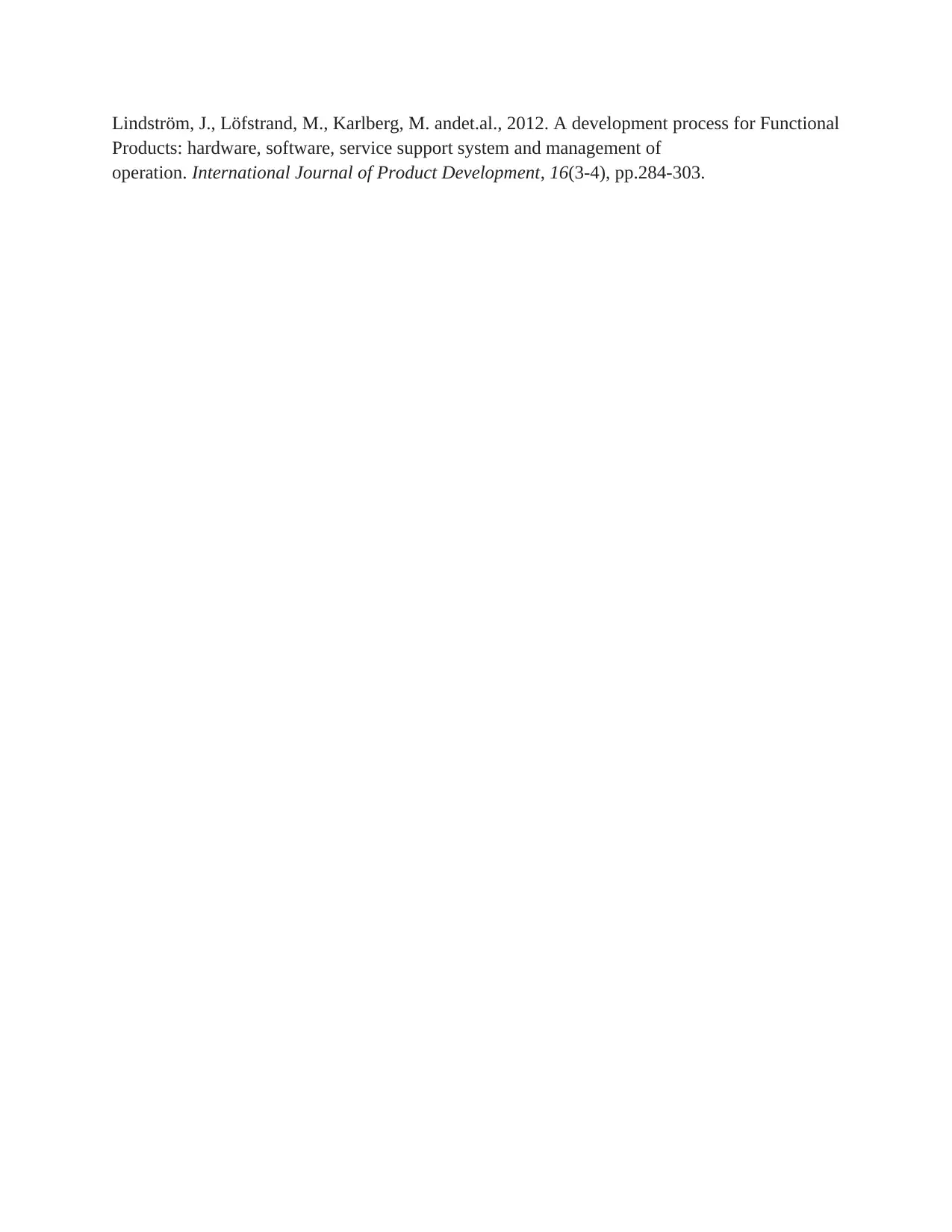
Lindström, J., Löfstrand, M., Karlberg, M. andet.al., 2012. A development process for Functional
Products: hardware, software, service support system and management of
operation. International Journal of Product Development, 16(3-4), pp.284-303.
Products: hardware, software, service support system and management of
operation. International Journal of Product Development, 16(3-4), pp.284-303.
1 out of 11
Related Documents
Your All-in-One AI-Powered Toolkit for Academic Success.
+13062052269
info@desklib.com
Available 24*7 on WhatsApp / Email
![[object Object]](/_next/static/media/star-bottom.7253800d.svg)
Unlock your academic potential
Copyright © 2020–2025 A2Z Services. All Rights Reserved. Developed and managed by ZUCOL.





